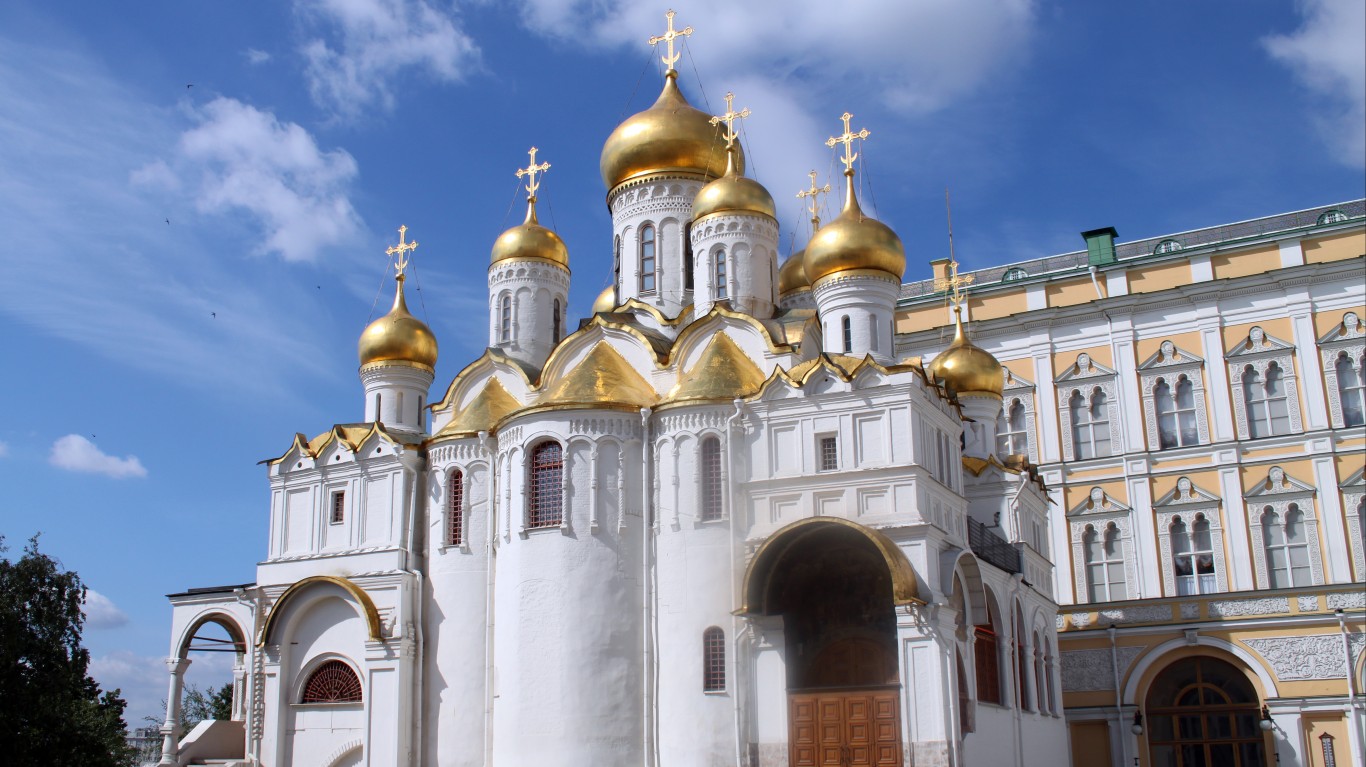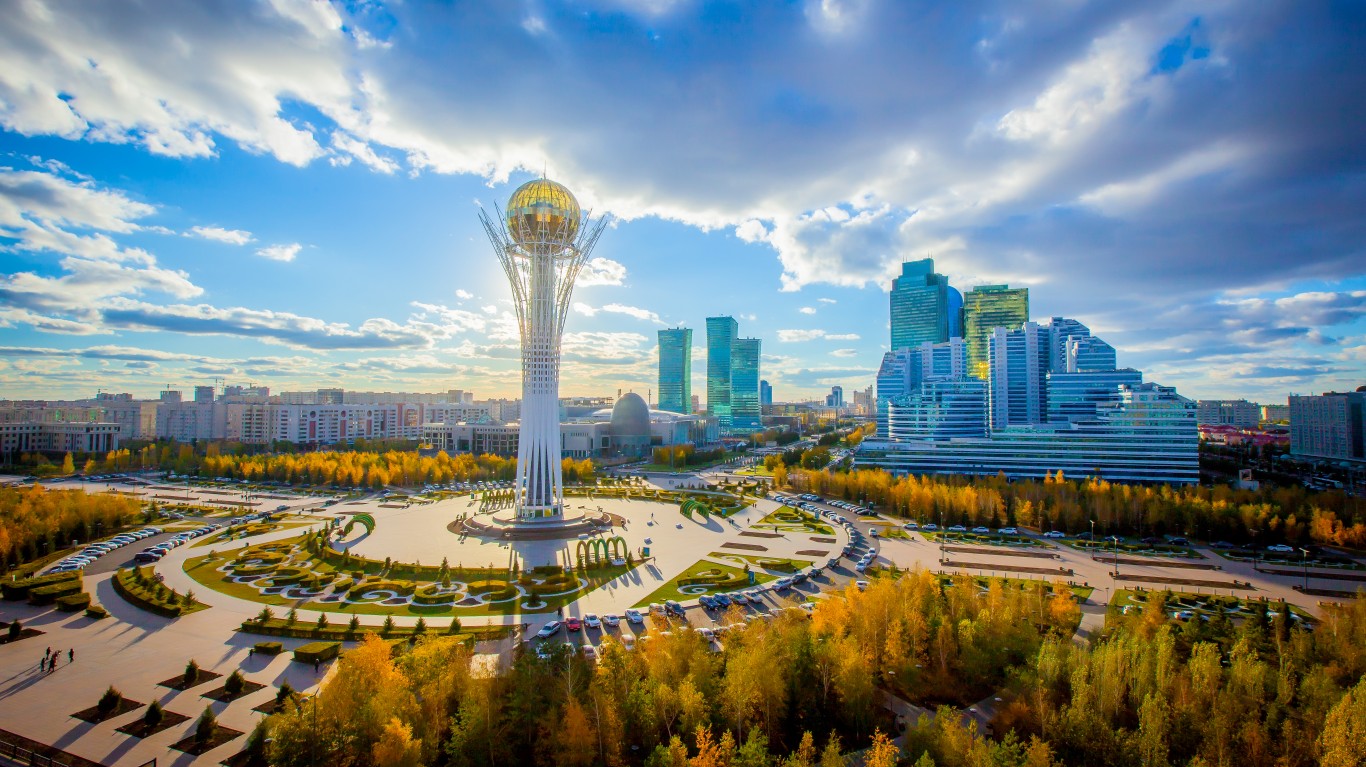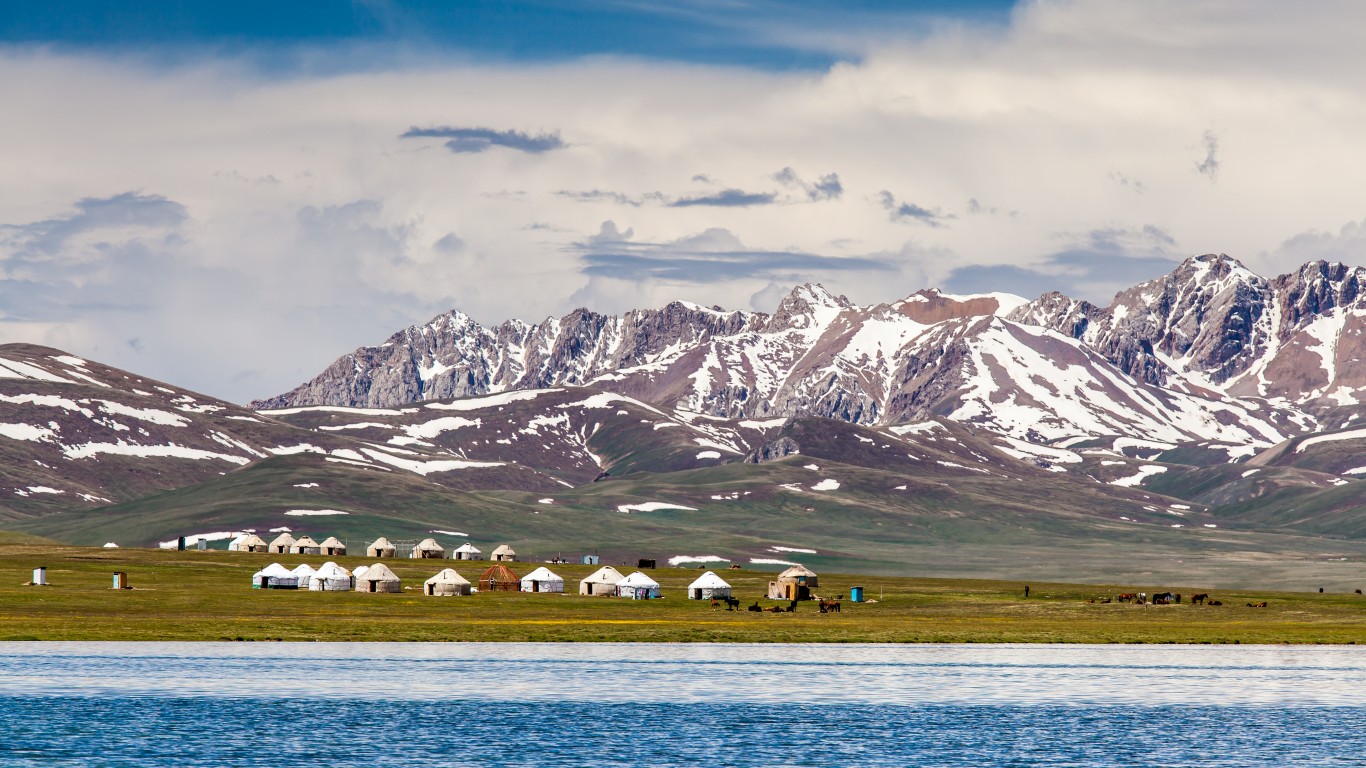Special Report
All of the Former Soviet Republics and What They're Called Today

Published:

In his televised speech to the Russian nation on Feb. 21, President Vladimir Putin proclaimed that “Ukraine never had a tradition of genuine statehood,” and that it “was entirely created by Russia.”
Historians (and not just Ukrainian ones) might well debate that, but in any case, when the Bolsheviks, under an earlier Vladimir – Lenin – established the Soviet Union in late 1922, Ukraine joined the USSR as one of its founding republics, along with what were then called Byelorussia and the Transcaucasian Federation (later separated into the republics of Armenia, Azerbaijan, and Georgia). It might be said, then, that instead of being created by Russia, Ukraine helped create the Soviet Union. (Here are 32 things you may not know about Ukraine.)
To assemble a list of the republics that were part of the former Soviet Union, 24/7 Wall St. consulted a number of historical and news sources, including History, Britannica, New World Encyclopedia, the BBC, Marxists, and the U.S. Office of the Historian. Population figures are from World Population Review.
Officially the USSR, or Union of Soviet Socialist Republics, the Soviet Union was conceived as a federation of national republics, which theoretically had the right to withdraw at any time (but good luck trying). It began growing in 1924, when the Turkmen and Uzbek regions, both of which had been taken over by Tsarist Russia in the 19th century, were named as member republics. Tajikistan was originally part of the Uzbeki republic, but separated into its own entity as part of the Soviet Union in 1929. Two other Central Asian republics, Kyrgyzstan and Kazakhstan, followed in 1936.
In 1940, after signing a non-aggression pact with the Nazis, the Soviets invaded and annexed the Baltic States – Estonia, Latvia, and Lithuania. The pact also ceded to them portions of Romania known as Bessarabia and Northern Bukovina and this new territory, called Moldova, became the 15th Soviet Socialist Republic. A 16th entity, the Karelo-Finnish Soviet Socialist Republic, was also established in 1940, but was assimilated into the Russian Soviet Federative Socialist Republic – the mother ship, as it were – in 1956. (These are the 14 former Soviet and Soviet-aligned republics that joined NATO after the Cold War.)
The USSR began to dissolve in 1988 under its liberalizing general secretary, Mikhail Gorbachev, in the face of political turmoil, a failing economy, and growing nationalist fervor among the republics – and successful anti-Soviet revolutions in the Eastern Bloc countries. Estonia struck the first blow by unilaterally declaring its sovereignty, though not its independence, in November that year. Lithuania went a step further in March of 1990, declaring its full independence. Latvia followed in May. Georgia was next, though not until the following April.
Click here to see what were the republics of the Soviet Union
At first, the Soviet Union refused to recognize these defections, and alarmed by the possibility of a weakened federation, hardline factions in the Soviet government and military attempted to overthrow Gorbachev on Aug. 18, 1991. The coup failed, and by the end of the month, all but four republics – one of them Russia itself – had declared independence. Gorbachev resigned on Christmas Day, yielding his powers to Boris Yeltsin. The following day, the Soviet parliament officially dissolved the Soviet Union and declared the creation of the Russian Federation.
When Yeltsin resigned in turn at the end of 1999, he appointed Vladimir Putin as his successor, and the rest, as they say, is history.

Armenian Soviet Socialist Republic
> Joined the U.S.S.R.: 1922 (as part of the Transcaucasian Federation)
> Declared independence: Sept. 21, 1991
> Name today: Armenia
> Population (2022): 2,971,966
[in-text-ad]

Azerbaijan Soviet Socialist Republic
> Joined the U.S.S.R.: 1922 (as part of the Transcaucasian Federation)
> Declared independence: Aug. 30, 1991
> Name today: Azerbaijan
> Population (2022): 10,300,205

Byelorussian Soviet Socialist Republic
> Joined the U.S.S.R.: 1922
> Declared independence: Aug. 25, 1991
> Name today: Belarus
> Population (2022): 9,432,800
Estonian Soviet Socialist Republic
> Joined the U.S.S.R.: 1940
> Declared independence: Aug. 20, 1991
> Name today: Estonia
> Population (2022): 1,321,910
[in-text-ad-2]

Georgian Soviet Socialist Republic
> Joined the U.S.S.R.: 1922 (as part of the Transcaucasian Federation)
> Declared independence: April 9, 1991
> Name today: Georgia
> Population (2022): 3,968,738

Kazakh Soviet Socialist Republic
> Joined the U.S.S.R.: 1936
> Declared independence: Dec. 16, 1991
> Name today: Kazakhstan
> Population (2022): 19,205,043
[in-text-ad]

Kirghiz Soviet Socialist Republic
> Joined the U.S.S.R.: 1936
> Declared independence: Aug. 31, 1991
> Name today: Kyrgyzstan
> Population (2022): 6,728,271

Latvian Soviet Socialist Republic
> Joined the U.S.S.R.: 1940
> Declared independence: May 4, 1990
> Name today: Latvia
> Population (2022): 1,848,837

Lithuanian Soviet Socialist Republic
> Joined the U.S.S.R.: 1940
> Declared independence: March 11, 1990
> Name today: Lithuania
> Population (2022): 2,661,708
[in-text-ad-2]

Moldavian Soviet Socialist Republic
> Joined the U.S.S.R.: 1940
> Declared independence: Aug. 27, 1991
> Name today: Moldova
> Population (2022): 4,013,171
Russian Soviet Federative Socialist Republic
> Joined the U.S.S.R.: 1922
> Declared independence: Dec. 25, 1991
> Name today: Russia
> Population (2022): 145,805,947
[in-text-ad]

Tajik Soviet Socialist Republic
> Joined the U.S.S.R.: 1929
> Declared independence: Sept. 9, 1991
> Name today: Tajikistan
> Population (2022): 9,957,464

Turkmen Soviet Socialist Republic
> Joined the U.S.S.R.: 1924
> Declared independence: Oct. 27, 1991
> Name today: Turkmenistan
> Population (2022): 6,201,943

Ukrainian Soviet Socialist Republic
> Joined the U.S.S.R.: 1922
> Declared independence: Aug. 24, 1991
> Name today: Ukraine
> Population (2022): 43,192,122
[in-text-ad-2]

Uzbek Soviet Socialist Republic
> Joined the U.S.S.R.: 1924
> Declared independence: Aug. 31, 1991
> Name today: Uzbekistan
> Population (2022): 34,382,084
The average American spends $17,274 on debit cards a year, and it’s a HUGE mistake. First, debit cards don’t have the same fraud protections as credit cards. Once your money is gone, it’s gone. But more importantly you can actually get something back from this spending every time you swipe.
Issuers are handing out wild bonuses right now. With some you can earn up to 5% back on every purchase. That’s like getting a 5% discount on everything you buy!
Our top pick is kind of hard to imagine. Not only does it pay up to 5% back, it also includes a $200 cash back reward in the first six months, a 0% intro APR, and…. $0 annual fee. It’s quite literally free money for any one that uses a card regularly. Click here to learn more!
Flywheel Publishing has partnered with CardRatings to provide coverage of credit card products. Flywheel Publishing and CardRatings may receive a commission from card issuers.
Thank you for reading! Have some feedback for us?
Contact the 24/7 Wall St. editorial team.